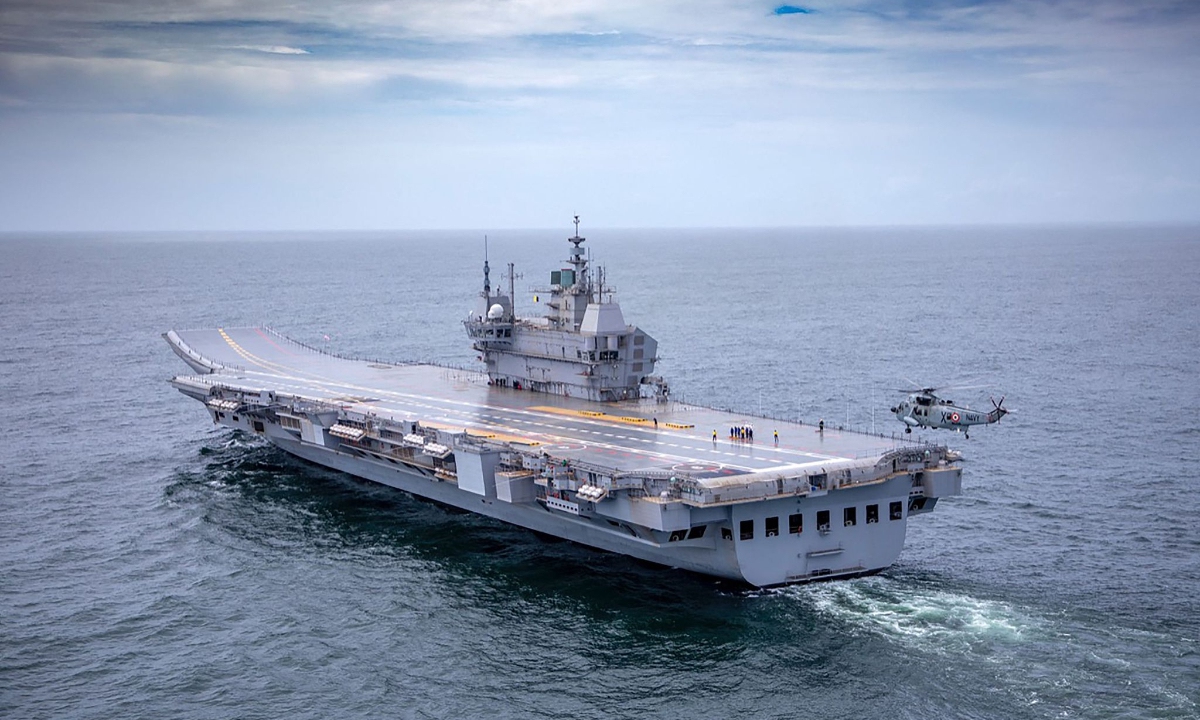
The Vikrant, India's first indigenous aircraft carrier Photo:VCG
India is reportedly set to acquire its second indigenous aircraft carrier to counter China, with analysts saying on Wednesday that being able to build one's own carriers is a great accomplishment, but building them only to "counter China" shows its tunnel vision.
Citing people familiar with the matter, Bloomberg reported on Tuesday that India's Defense Acquisition Council is expected to approve on Friday the acquisition of the country's second indigenous aircraft carrier, worth around $4.8 billion.
India now operates its first homemade carrier, the INS
Vikrant, which joined the fleet last year, and a Russia-made carrier, the INS
Vikramaditya.
A three-carrier battle group "will be a show of strength for the Indian navy in the Indian Ocean at a time when the [Chinese People's Liberation Army (PLA) Navy] is increasingly marking its presence in the region," Bloomberg quoted its sources as saying.
India is carrying out more warship patrols than ever before "amid growing concerns over China's rising naval prowess," the report said.
"Not many countries in the world can independently build aircraft carriers, so in that sense, India has made a great accomplishment. India can rightfully develop its navy, but if its strategy is aimed at China, then it has tunnel vision," a Beijing-based military expert who requested anonymity told the Global Times on Wednesday.
China pursues a national defense policy that is defensive in nature, and so as long as India does not provoke China, China is no enemy to India, the expert said.
The PLA Navy's presence in the Indian Ocean is not targeted at India, but for peaceful purposes and providing international public security goods including escort duties, safeguarding commercial sea lanes and delivering humanitarian aid, from which India also benefits, the expert said.
China regularly sends naval escort task forces on routine escort missions in the Gulf of Aden and the waters off Somalia. Each task force usually consists of a destroyer, a frigate and a replenishment ship, and a Chinese aircraft carrier has yet to sail in the Indian Ocean.
India's new carrier is expected to hold at least 28 fighter jets and helicopters, including French Rafale fighter jets, and displaces 45,000 tons of water, Bloomberg reported.
By comparison, the
Fujian, China's second domestically developed aircraft carrier and the third overall, already launched in June 2022.
It displaces over 80,000 tons and is equipped with electromagnetic catapults that can launch heavier warplanes faster than ski-jump ramps, making it a much superior carrier than the one India is planning, analysts said.
India's first indigenous carrier, the INS
Vikrant, is also no match for China's first domestically built carrier, the
Shandong. The INS
Vikrant has yet to reach creditable operational capability today although its construction started far earlier than the
Shandong, while the
Shandong has demonstrated its combat capabilities in several far sea exercises in the West Pacific this year, observers said, questioning the efficiency of India's shipbuilding industry and its navy.




